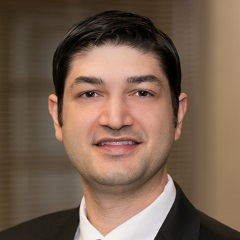Cervical Degenerative Disc Disease Natural Part of Aging
Condition may be root cause of back pain, tingling in arms
 DAYTON, Ohio (December 10, 2018) – A prolonged bout with back pain or unexplained tingling in the arms may actually turn out to be degenerative disc disease.
DAYTON, Ohio (December 10, 2018) – A prolonged bout with back pain or unexplained tingling in the arms may actually turn out to be degenerative disc disease.
The condition’s name may seem daunting to some, but in reality it’s a common part of aging for most, said Neal Mehan, MD, a spine neurosurgeon with the Clinical Neuroscience Institute.
In a young and healthy back, discs between the vertebra provide height and allow bending, flexion and twisting. The discs act like shock absorbers between bones of the spine and are designed to help the back stay flexible while resisting forces, the Arthritis Foundation said.
“As we age, we lose the water content of the discs in our spine and eventually they become rigid and are prone to injury,” said Dr. Mehan, who practices with Premier Physician Network. “Degenerative discs can cause pinching of the spinal cord or the nerves in the spine.”
The symptoms of disc disease can vary from the pinching of the nerves, which can cause pain, numbness or tingling in a person’s arms, to pinching of the spinal cord, which can cause a person to have trouble walking. Many of the condition’s symptoms are shared by other disorders, which can make an initial diagnosis difficult. Disc disease may be mistaken for a pinched nerve in the neck. Likewise, shoulder pain caused by disc disease may first be thought of as a problem with the rotator cuff.
Medical imaging studies have shown that nearly everyone over the age of 60 has degeneration of the discs, but not everyone has pain. Still, most individuals who will suffer from symptoms of the disease will seek medical help at a younger age. According to healthcare research firm PearlDriver, which creates and analyses patient record databases, the condition is most commonly diagnosed in patients aged 40 to 55 years of age.
Age is the primary risk factor for degenerative disc disease, but there are other things that can increase a person’s risk for developing it such as smoking and a history of trauma to the back from an accident or fall, Dr. Mehan said.
Degenerative disc disease often produces symptoms in the lower back or neck, depending on where the affected discs are located. Understanding its symptoms and signs can help lead to a more accurate diagnosis. The following symptoms may signal degenerative disc disease:
Degree of pain – Degenerative discs can produce pain that ranges from nagging to severe and disabling.
Location of pain – Consider where the pain resides. Degenerative discs usually affect the lower back, buttocks and thighs. Neck pain may also radiate to the arms or hands.
Painless signs – Degenerative discs may not always produce pain but rather numbness or tingling in the extremities. It may also cause weakness in leg muscles.
The body’s position – Degenerative discs can produce pain that gets worse when sitting or is exacerbated when bending, lifting or twisting.
What brings relief – Pain from degenerative discs usually lessens when walking, moving, changing positions or when lying down.
Treatment for degenerative disc disease can range from conservative methods such as physical therapy to surgery that replaces damaged discs or fuses the spine together. Self-care measures can often help keep the disease in check. This requires getting the proper amount of physical activity, eating a balanced diet and engaging in strengthening exercises aimed at muscles that support the back.
Contact Us
Discover more about Premier Health and join us in building healthier communities in Southwest Ohio. Learn more about working at Premier Health, becoming a volunteer, and making a gift to support our mission.

